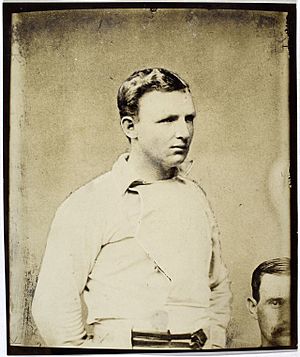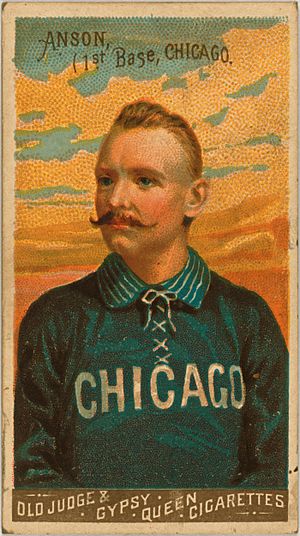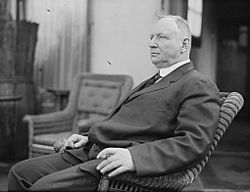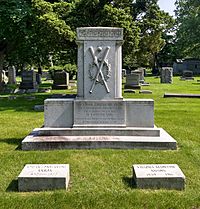Cap Anson facts for kids
Quick facts for kids Cap Anson |
|||
|---|---|---|---|
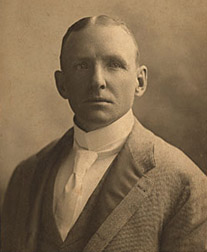 |
|||
| First baseman | |||
| Born: April 17, 1852 Marshalltown, Iowa, U.S. |
|||
| Died: April 14, 1922 (aged 69) Chicago, Illinois, U.S. |
|||
|
|||
| debut | |||
| May 6, 1871, for the Rockford Forest Citys | |||
| Last appearance | |||
| October 3, 1897, for the Chicago Colts | |||
| MLB statistics | |||
| Batting average | .334 | ||
| Hits | 2,995–3,435 | ||
| Home runs | 97 | ||
| Runs batted in | 2,075 | ||
| Managerial record | 1,295–947 | ||
| Winning % | .578 | ||
| Teams | |||
As player
As manager
|
|||
| Career highlights and awards | |||
|
|||
| Induction | 1939 | ||
| Election Method | Veterans Committee | ||
Adrian Constantine Anson (born April 17, 1852 – died April 14, 1922) was a famous American Major League Baseball (MLB) first baseman. People called him "Cap" because he was often a team captain, and sometimes "Pop". He played for a record 27 seasons, which is a very long time in baseball!
Many people thought Cap Anson was one of the best players of his time. He was one of the first true superstars in baseball. He spent most of his career with the Chicago Cubs team, which was known as the "White Stockings" and later the "Colts." He was their manager, played first base, and even owned a small part of the team. He helped his team win six championships in the 1880s.
Cap Anson was one of baseball's first great hitters. He was probably the first player to get over 3,000 hits in his career. Besides being a star player, he also came up with new ways to manage a team. For example, he used signals between players and rotated pitchers.
However, Cap Anson also played a big part in keeping professional baseball segregated. This meant that black players were not allowed to play in the major leagues until the late 1940s. He sometimes refused to play if the other team had black players. His actions may have influenced team owners to ban new contracts with black players in 1887.
After he stopped playing and managing the Colts, Anson briefly managed the New York Giants. He also started several businesses in Chicago, like a billiards and bowling hall. He even had his own semi-professional baseball team called "Anson's Colts." Anson also performed on stage, telling stories and singing. Many of his businesses didn't do well, and he lost his share of the Cubs team. Cap Anson was honored by being put into the National Baseball Hall of Fame in 1939.
Contents
Early Life and Education
Cap Anson was born in Marshalltown, Iowa. When he was about 14 years old, he went to a boarding school at the University of Notre Dame. His father sent him there hoping it would help him behave better.
After Notre Dame, he went to the University of Iowa. But he only stayed for one semester before the school asked him to leave.
Professional Baseball Career
Starting in the National Association
Cap Anson played on many good baseball teams when he was young. He started playing professionally in the National Association (NA) when he was 19. He mostly played third base for the Rockford Forest Citys, one of the first teams in that league.
Anson was a big and strong player. He was about 6 feet 2 inches tall and weighed around 220 pounds.
After moving to the Philadelphia Athletics, Anson was one of the best players in the NA in 1872 and 1873. He was great at hitting and getting on base. In 1872, he led the NA in getting on base.
His performance was still good enough that the Chicago White Stockings wanted him for the 1876 season. The Chicago team's president, William Hulbert, broke league rules by talking to Anson and other star players while the 1875 season was still going on. Hulbert then started a new league, the National League, to avoid getting in trouble.
Anson wasn't sure about moving to Chicago because he was engaged to someone from Philadelphia. But Hulbert made him stick to his contract, and Anson eventually grew to like Chicago.
Playing for Chicago White Stockings/Colts
The White Stockings won the first league title in the new National League. Anson was a good hitter, but he became a superstar after he was named captain and manager in 1879.
His new job as captain led to his nickname "Cap." With Anson leading the way, the White Stockings won five championships between 1880 and 1886. They won by using new managing ideas. These included having a third-base coach, players helping each other in the field, giving signals to batters, and rotating two star pitchers.
In the early 1880s, Anson had his players run the bases very aggressively. This made the other team make mistakes. He also claimed to use some of the first "hit and run" plays.
Anson and the Chicago club president, Albert Spalding, helped start modern spring training. They were among the first to send their teams to warmer places in the South, like Hot Springs, Arkansas, to get ready for the season. This started in 1886.
On the field, Anson was the team's best hitter and helped score many runs. In the 1880s, he won two batting titles (in 1881 and 1888). He also led the league in runs batted in (RBIs) seven times. His best season was in 1881, when he led the league in batting average (.399), hits (137), and RBIs (82).
He was also the first player to hit three home runs in a row. He was also the first to hit five home runs in two games, and four doubles in one game. He is one of the few players to score six runs in a single game, which he did on August 24, 1886.
As the 1880s ended, the team started trading away its star players for younger ones. Anson was one of the few older players who stayed. Local newspapers started calling the team "Anson's Colts" or just "Colts." When the team lost many players in 1890, the nickname "Colts" became very common.
Anson also became a bit more relaxed and was often called "Pop." When he was fired as manager after the 1897 season, his 27-year playing career also ended. The next season, newspapers called the team the "Orphans" because they had lost their "Pop."
Racial Issues in Baseball
Even though team owners made the final decision to ban black players, Cap Anson was the most vocal player who insisted on keeping baseball segregated. As a star player and manager, his opinion was very important.
Some historians believe Anson had a huge impact on baseball because of his role in this discrimination. Other historians say that segregation would have happened in baseball even if Anson had not been born.
On August 10, 1883, Anson refused to play a game against the Toledo Blue Stockings. This was because their catcher, Moses Fleetwood Walker, was black. When the Toledo manager said Anson's team would lose money if they didn't play, Anson gave in. But he promised his team would not play in such a game again.
In 1884, Chicago played another game against Toledo. Walker did not play in this game. It's not clear if he sat out to avoid problems with Anson or because he was injured.
On July 14, 1887, the Chicago White Stockings played against the Newark Little Giants. An African American player named George Stovey was supposed to pitch for Newark. Anson objected, and Stovey did not pitch. On the same day, league owners voted to stop signing new contracts with African-American players.
Working with Albert Spalding
Cap Anson first met Albert Spalding when they were both players. Spalding was a pitcher and convinced 18-year-old Anson to play for his team. In 1876, Spalding and William Hulbert convinced Anson to join the Chicago team, which Spalding then managed.
Spalding stopped playing and managing after the 1877 season. He became the secretary, and later president, of the White Stockings. Anson became the player/manager in 1879. By 1889, he owned a small part of the team.
In 1888, Spalding announced that the White Stockings, including Anson, would go on a World Tour after the season. Spalding paid most of the money, but Anson also invested some of his own.
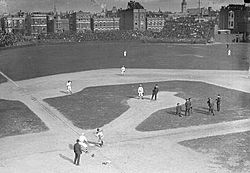
After Spalding stepped down as president of the Chicago club in 1891, he chose James Hart for the job. Anson felt he should have been chosen instead. Spalding, however, still had a lot of control over the team.
By 1897, Anson had less control over his players. After Anson complained publicly about his team, his time as manager was almost over. Spalding tried to get Anson to retire on his own, but Anson didn't want to. Finally, in January 1898, Spalding announced that Anson had been manager for too long and it was time for a change.
Career Hits Total
There has been some discussion about whether Cap Anson was the first player to reach the 3,000 hit milestone. For many years, official records said he did.
One reason for the confusion is a rule from 1887 that counted walks as hits. This rule was only used for one season. When those walks were removed from his total, his hits went down to 2,995.
Another reason for different numbers is whether to count his years in the National Association. Major League Baseball (MLB.com) does not count his time in the NA. They say he had 3,011 hits in the National League, which puts him 25th on the all-time list.
Other sources have different numbers because record keeping in baseball was not always perfect until the 1900s.
The National Baseball Hall of Fame says Anson had 3,081 hits. This number does not include his NA games but does include the walks from 1887.
Life After Baseball
Anson briefly returned to baseball as a manager for the New York Giants in 1898. He then tried to buy a team in another league but didn't succeed. In 1900, he helped start a new baseball league, but it closed before any games were played.
After several business attempts that didn't work out, he was elected city clerk of Chicago in 1905. He served one term but lost when he tried to become sheriff in 1907.
In 1907, Anson tried to get back into baseball by getting a semi-pro team called "Anson's Colts." He didn't plan to play, but in June 1907, at 55 years old, he started playing first base to try and get more people to come to the games. Even with Anson playing, the team didn't make much money. In 1908, he also put together a semi-pro football team, also called Anson's Colts, which won the city championship but wasn't a financial success.
One of Anson's few successful businesses was a billiards hall and bowling alley he opened in Chicago in 1899. He was even named vice-president of the American Bowling Congress in 1903. However, he had to sell the hall in 1909 because of money problems, which led to him going bankrupt. Anson also loved to play golf.
Anson wrote a book in 1900 called A Ball Player's Career: Being the Personal Reminiscences of Adrian C. Anson. A writer helped him put it together. People said the book sounded just like Anson.
Anson also started acting during his baseball career. He appeared in plays and later toured on the vaudeville circuit, which was a popular type of stage show at the time. He would tell stories and sing. He even appeared with his two grown daughters, Adele and Dorothy, and would hit fake baseballs into the audience. He stopped performing in 1921.
Anson retired from vaudeville in 1921. He refused a pension from Major League Baseball, even though he didn't have other income. In April 1922, he became the general manager of a new golf club in Chicago.
Death
Cap Anson died on April 14, 1922, just three days before his 70th birthday. He was buried at the Oak Woods Cemetery in Chicago.
Legacy and Records
Cap Anson was put into the Baseball Hall of Fame in 1939. He was one of the first players from the 1800s to be chosen. Even today, over 100 years after he stopped playing, he still holds several Cubs team records. These include the most career RBIs, runs, hits, singles, and doubles. He is also the only Cub in the 3,000 hit club.
As a manager, he was the second manager ever to reach 1,000 wins. Anson won 1,282 games with the Cubs, which is still a team record. Only 24 other managers in Major League Baseball have won 1,000 games with one team.
In a 1992 episode of The Simpsons called "Homer at the Bat", Cap Anson was mentioned by Mr. Burns as a player for his all-star baseball team. However, Mr. Burns was then told that Anson and the other players he named had already passed away.
Family Life
In 1872, when he was 20, Cap Anson met Virginia Fiegal, who was 13. She was the daughter of a restaurant owner in Philadelphia. They got married on November 21, 1876, and stayed married until she passed away in 1915. For the first seven years, they lived in Chicago during baseball season and Philadelphia in the off-season. Later, they moved to Chicago year-round.
The Ansons had seven children, but sadly, three of them died when they were babies. Their children were Grace (born 1877), Adrian Hulbert (born 1882, died soon after), Adele (born 1884), Adrian Constantine, Jr. (born 1887, died soon after), Dorothy (born 1889), John Henry (born 1892, died soon after), and Virginia Jeanette (born 1899).
See also
 In Spanish: Cap Anson para niños
In Spanish: Cap Anson para niños


